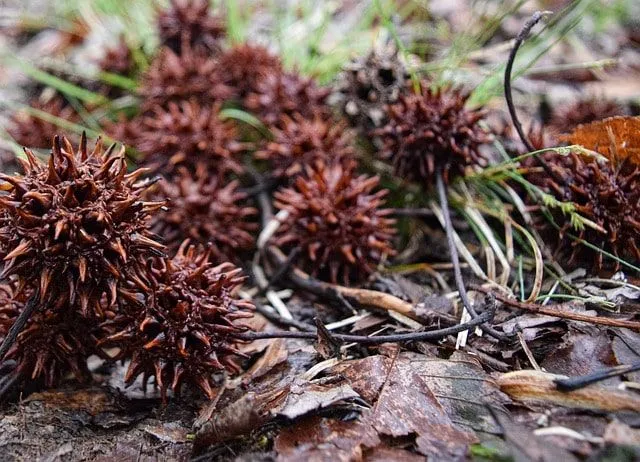FOR ALL AGES
You may have heard of gum trees, but are you familiar with the sweet gum tree?
The term 'gum tree', is usually used in reference to trees like the eucalyptus, which have a smooth trunk and release a thick sap. Although they do have this in common, sweet gum trees are not usually included under this very similar term...confusing!
So what does a sweetgum tree look like? Well, very different to the eucalyptus! Sweet gum tree leaves are large and star shaped, and the bark of this tree is extremely furrowed and not at all smooth. These trees are pretty spectacular to look at (check out our pictures of sweet gum trees!), however due to the spiky tree balls they grow and then promptly drop everywhere, they aren't exactly barefoot friendly.
If you are curious about the sweetgum liquidambar styraciflua (there's a mouthful!), check out our list of facts about the star shaped leaf tree.
When you have had your fill of American sweet gum tree facts, why not check out some other nature loving lists such pecan tree facts and facts about flowers?
For some quick fire facts about the sweet gumball tree, check this list out, from height and leaves to chewing gum and chipmunks!
1. The sweetgum tree is most commonly found in Mexico and Central America.
2. Whilst it is most common in Central America, species of sweetgum trees can be found all around the world, from North America (liquidambar styraciflua) to Greece,Turkey (liquidambar orientalis) and China (liquidambar acalycina).
3. This deciduous tree got its name from the gummy texture of its sap, which also happens to be one of the earliest versions of chewing gum!
4. Sweetgum trees are easy to recognize. They grow hard spiky fruit, or gumballs, and have star shaped leaves similar to those of a maple tree.
5. The sweet gum flowers bloom from March to May. Each sweetgum flower will grow as a spherical head nestled in an upright cone shaped cluster.
6. Sweetgum trees are considered medium to large, on average they grow to a height of 50 to 70 feet, but in the right conditions they have been known to reach over 100 feet in height.
7. The average diameter of an adult sweetgum tree’s trunk is usually somewhere between 24 and 36 inches.
8. Height, sprawling branches and wide leaves combined, these trees are popular in public parks as they create just the right amount of shade.
9. The sweetgum tree won't flower or produce their gum balls for the first 15 to 20 years of growth, but they will go on to live for 150 to 400 years so there is plenty of time!
10. The sweetgum tree attracts a great deal of wildlife including blue jays, cardinals, mourning doves, squirrels, chipmunks and even luna moths.
11. These American sweet gumball trees are a popular choice of hardwood in the United States. They can be used for lumbar, veneer and plywood.

You may not have come across a tree with green spiky balls and or even gumballs from trees at all! For the sweetgum tree, its spiky gumballs are its most distinguishing feature!
12. The spiky gumballs the sweetgum tree produces are the containers for its seeds. These spiked seed balls are often referred to as gum balls, spiky nuts, sweet gum fruit, burr balls, sticker balls and sweet gumballs.
13. Each of these gum balls contain a cluster of around 60 capsule fruits, and then each fruit holds one or two seeds.
14. The spikes on these gumballs serve a purpose. They allow the seeds to carried away by animals! The seeds stick to the animals fur and they can be carried far and wide, when they fall off they can create new sweetgum trees.
15. The sweetgum seeds are produced by fertilized flowers. The sweetgum tree bears both male and female flowers, this clever trick means that only one tree is needed for pollination!
16. There is one sweetgum tree that does not produce gumballs, the Rotundiloba (liquidambar styraciflua rotundiloba). This particular liquid amber tree is sterile.
17. These spiky little sweet gum pods are full of nutrients making them great food for chipmunks, birds and squirrels.
Did you spot our use of the American sweetgum scientific name above? Test your sweetgum scientific knowledge with these facts.
18. The scientific name for the sweetgum tree is 'liquidambar styraciflua'.
19. It is of the liquidambar genus, and the altingiaceae family.
20. The sweetgum tree is deciduous tree, meaning it sheds its leaves annually. For much of the year the sweetgum's star shaped leaves are glossy green, and in autumn they will change to an array of amazing colours, from bright orange to deep purple.
21. Liquidambar is a genus of only 15 species of trees, including the American sweetgum.
22. The name liquidambar, literally means "liquid amber" and refers to the resin these trees produce if you peel back the bark.
23. Another name for the sweetgum tree's resin is storax.
24. The sweetgum tree is known as Alligator Wood in some parts of the American South, this is because the scaly sweetgum bark looks just like the alligator's hide.
25. Sweet gum leaves are star shaped with between five and seven pointed lobes with veins that connect to a notched base.
26. The sweetgum tree is very fast growing and is highly resistant to insects. This makes them the perfect species of tree for reforestation projects.
27. The sweetgum tree is used to fix nitrogen in soil and improve its fertility, these trees are also used to reclaim former zinc and phosphorus mines. In other words, they are good for the soil!
28. In the wild, sweet gum trees will provide cover for many forest animals including wood ducks, white tailed deer, mourning doves, beavers and Eastern gray squirrels.

Pretty much every part of the sweetgum tree has been found to contain healing properties that can be used for medicinal purposes. The sap, resin, leaves and bark can all be used in some way, whether it is as a balm, made into a tea, or even applied directly.
29. Indigenous Americans were the first to use the resin from the sweetgum tree to maintain dental hygiene, the antiseptic properties make it great for eliminating bacteria from the mouth.
30. When added to tobacco and smoked through a pipe, it was believed that the resin of the sweet gum tree was a great pain reliever, that could also aid sleep and even relieve wind!
31. Three species of sweet gum tree have been shown to possess antioxidant potential.
32. The sweetgum tree bark has astringent properties, believed to help with dysentery and diarrhea.
33. Indigenous American Cherokee tribes would apply the resin from of the sweetgum tree directly to wounds to help heal them.
34. The anti inflammatory sweet gum tree resin has also been used to treat bedsores and angina.
35. The sap of the sweetgum tree is also useful. By boiling it and letting it cool, it can be made into a medicinal balm that is rich in cinnamyl cinnamate, ethyl, nenzyl and cinnamic acid. This balm can then be used to treat many topical ailments as cinnamic acid is known to have both antimicrobial and antioxidant properties.
36. Sweet gum leaf oil taken from the species liquidambar orientalis and liquidambar styraciflua was found to contain many of the same ingredients as tea tree oil, a well known antimicrobial.
37. American sweet gum balls can be burnt down to ash and made into a healing salve by mixing the ash with grease.
38. In China, the spiky fruit of the sweet gum tree has been used in herbal medicines as a cure for indigestion and anemia.
39. Within Chinese medicine, the properties of the sweet gum seed are also believed to be able to unblock energy pathways and enable the spread of qi, a vital force in traditional Chinese medicine.
40. The sweet gum tree fruit has been found to be effective against rheumatic pain.
41. As well as all these medicinal properties, did you know you can make an effective toothbrush from a twig of the liquidambar styraciflua? Explorers in need have been able to cut a twig around four to six inches long, remove any leaves and carefully score one end along the long edge. The scored bits of wood will fray and they can then chew on it for a while to create bristles! They have to brush one tooth at a time with this method, but it's better than nothing, right?
Here at Kidadl, we have carefully created lots of interesting family-friendly facts for everyone to enjoy. If you liked our facts about sweet gum trees, then why not take a look at these calico cat facts, or milk facts?
Read The Disclaimer
At Kidadl we pride ourselves on offering families original ideas to make the most of time spent together at home or out and about, wherever you are in the world. We strive to recommend the very best things that are suggested by our community and are things we would do ourselves - our aim is to be the trusted friend to parents.
We try our very best, but cannot guarantee perfection. We will always aim to give you accurate information at the date of publication - however, information does change, so it’s important you do your own research, double-check and make the decision that is right for your family.
Kidadl provides inspiration to entertain and educate your children. We recognise that not all activities and ideas are appropriate and suitable for all children and families or in all circumstances. Our recommended activities are based on age but these are a guide. We recommend that these ideas are used as inspiration, that ideas are undertaken with appropriate adult supervision, and that each adult uses their own discretion and knowledge of their children to consider the safety and suitability.
Kidadl cannot accept liability for the execution of these ideas, and parental supervision is advised at all times, as safety is paramount. Anyone using the information provided by Kidadl does so at their own risk and we can not accept liability if things go wrong.
Kidadl is independent and to make our service free to you the reader we are supported by advertising.
We hope you love our recommendations for products and services! What we suggest is selected independently by the Kidadl team. If you purchase using the buy now button we may earn a small commission. This does not influence our choices. Please note: prices are correct and items are available at the time the article was published.
Kidadl has a number of affiliate partners that we work with including Amazon. Please note that Kidadl is a participant in the Amazon Services LLC Associates Program, an affiliate advertising program designed to provide a means for sites to earn advertising fees by advertising and linking to amazon.
We also link to other websites, but are not responsible for their content.
Was this article helpful?



Browse Category



We’ll send you tons of inspiration to help you find a hidden gem in your local area or plan a big day out.



Check your inbox for your latest news from us. You have subscribed to:
Remember that you can always manage your preferences or unsubscribe through the link at the foot of each newsletter.